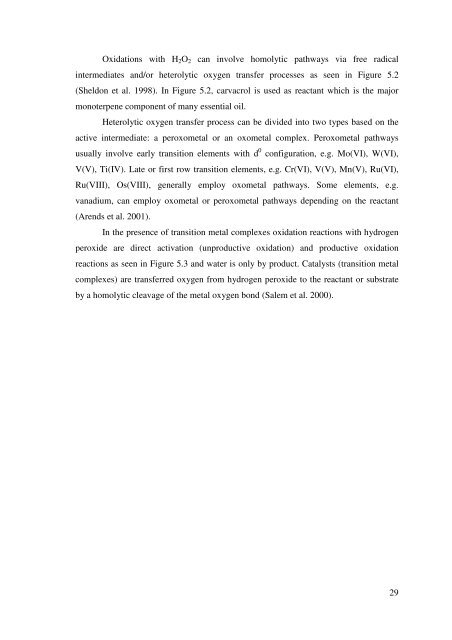the production of thymoquinone from thymol and carvacrol
the production of thymoquinone from thymol and carvacrol
the production of thymoquinone from thymol and carvacrol
You also want an ePaper? Increase the reach of your titles
YUMPU automatically turns print PDFs into web optimized ePapers that Google loves.
Oxidations with H2O2 can involve homolytic pathways via free radical<br />
intermediates <strong>and</strong>/or heterolytic oxygen transfer processes as seen in Figure 5.2<br />
(Sheldon et al. 1998). In Figure 5.2, <strong>carvacrol</strong> is used as reactant which is <strong>the</strong> major<br />
monoterpene component <strong>of</strong> many essential oil.<br />
Heterolytic oxygen transfer process can be divided into two types based on <strong>the</strong><br />
active intermediate: a peroxometal or an oxometal complex. Peroxometal pathways<br />
usually involve early transition elements with d 0 configuration, e.g. Mo(VI), W(VI),<br />
V(V), Ti(IV). Late or first row transition elements, e.g. Cr(VI), V(V), Mn(V), Ru(VI),<br />
Ru(VIII), Os(VIII), generally employ oxometal pathways. Some elements, e.g.<br />
vanadium, can employ oxometal or peroxometal pathways depending on <strong>the</strong> reactant<br />
(Arends et al. 2001).<br />
In <strong>the</strong> presence <strong>of</strong> transition metal complexes oxidation reactions with hydrogen<br />
peroxide are direct activation (unproductive oxidation) <strong>and</strong> productive oxidation<br />
reactions as seen in Figure 5.3 <strong>and</strong> water is only by product. Catalysts (transition metal<br />
complexes) are transferred oxygen <strong>from</strong> hydrogen peroxide to <strong>the</strong> reactant or substrate<br />
by a homolytic cleavage <strong>of</strong> <strong>the</strong> metal oxygen bond (Salem et al. 2000).<br />
29
















